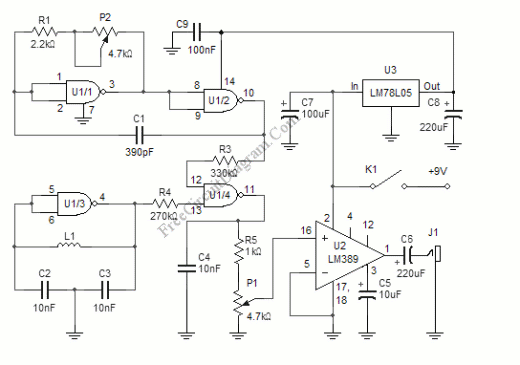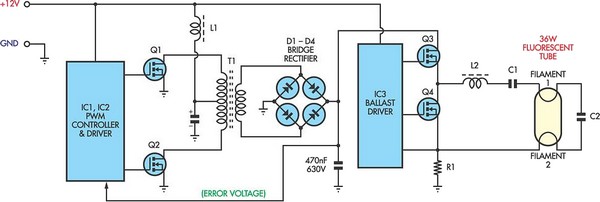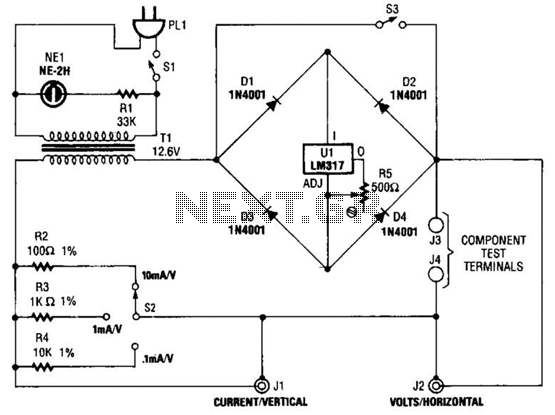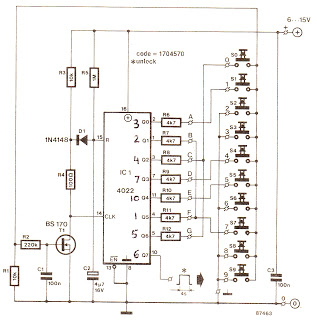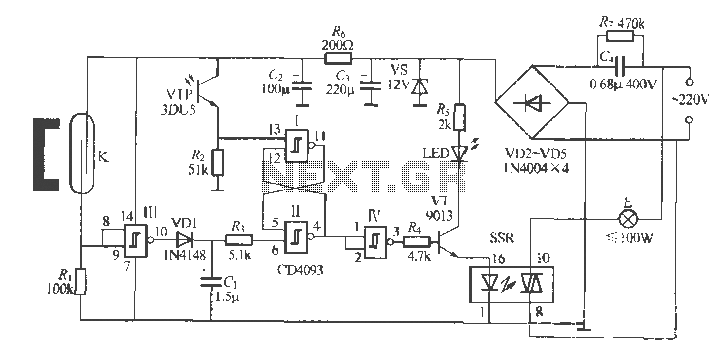
Simple Emergency Lamp
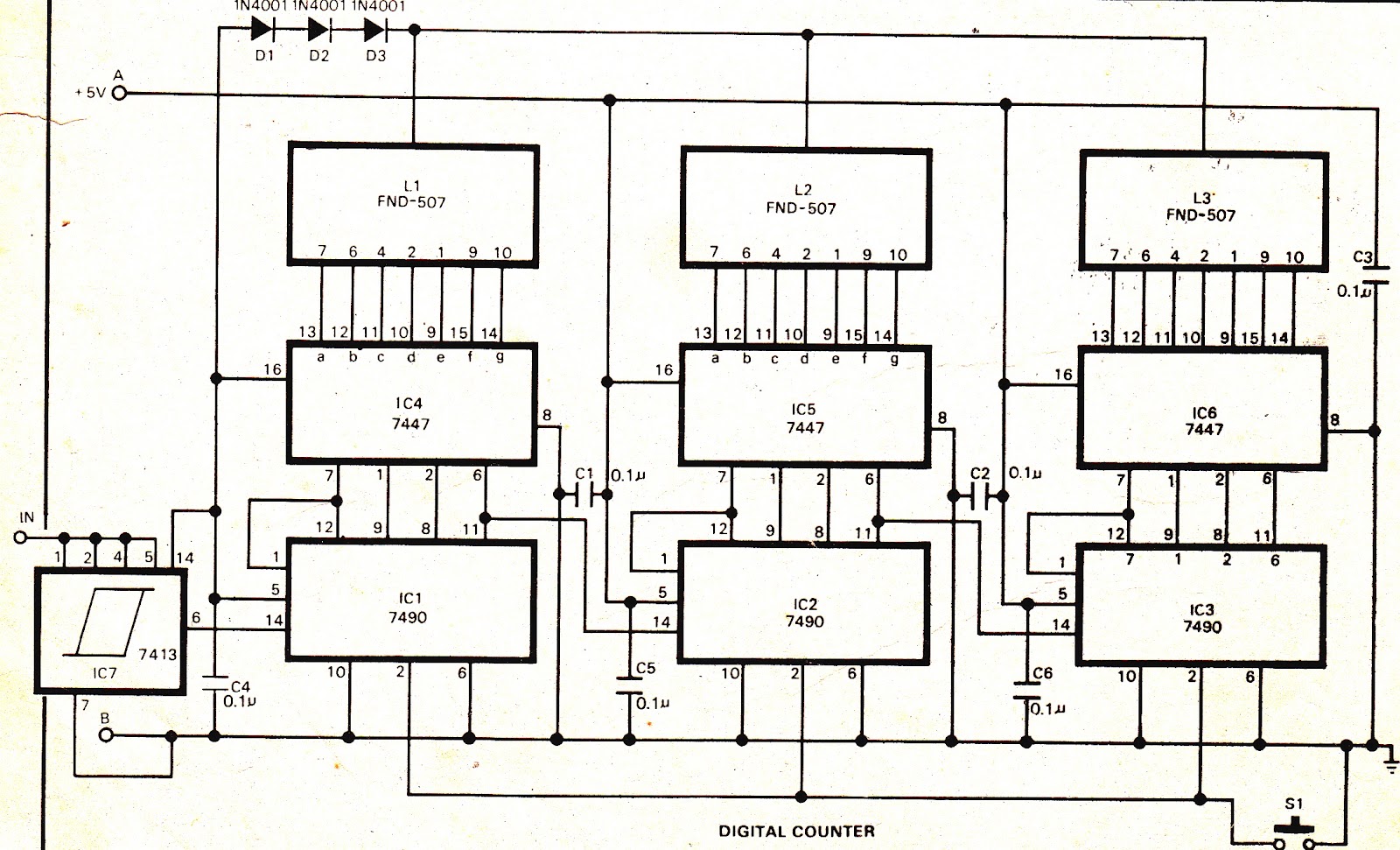
The circuit within the dotted line for a mini emergency light can be integrated into any battery eliminator, provided the eliminator's voltage exceeds that of the battery. For increased load capacity (i.e., for greater illumination through a larger lamp), transistor T1 should be a power transistor such as AD149. The diode in the circuit prevents current from flowing from the battery in the emergency light to the radio during a power failure. The radio can be turned off using its switch. The subsequent circuit of a simple LED flasher can be employed for various indication purposes in stereo amplifiers, tape recorders, decorative dolls, etc. All components are readily available locally, and the project would cost approximately Rs 12, excluding the power supply. A Schmitt trigger provides regenerative switching, and resistor R1 facilitates the necessary charge/discharge bistable action as T1 is toggled on and off. Resistors R3 and R4 determine the on and off times, respectively. The brightness of the LED is adjusted by R1 and Vg. Depending on the capacitor used, the R-C time constant can be modified. IC3 is similarly connected to receive input from IC2. The outputs of each decade counter are taken in BCD (binary coded decimal) format, transmitted through the IC 7447 BCD to 7-segment decoder driver, and displayed on the corresponding FND 507 LED display. These shaped pulses are counted by a series of three decade chain counters utilizing three 7490 ICs. The input is provided to pin 14 of IC1, and the output from pin 11 of this IC is routed to pin 14 of IC2. Consequently, the contents of IC1, IC2, and IC3 are displayed as L1 (hundreds), L2 (tens), and L3 (units), respectively. Capacitors C1-C6 are employed for noise rejection. A series of three diodes, all of the 1N4001 type, are utilized for current limiting of the displays and for maintaining unidirectional current flow. Switch S1 resets the counter. The circuit diagram of the regulated +5V supply is illustrated in Fig. 2. The mains voltage is stepped down to 9V AC by transformer X1, rectified by a bridge rectifier composed of four diodes (D4-D7), and regulated to +5V by IC5 (7805).
The mini emergency light circuit is designed to operate effectively when integrated with a battery eliminator, ensuring that the voltage supplied is always higher than that of the battery. The use of a power transistor like AD149 for T1 allows the circuit to handle larger loads, making it suitable for applications requiring more intense lighting. The inclusion of a diode serves a critical role in protecting the radio from reverse current during power outages, enhancing the overall reliability of the system.
The LED flasher circuit described is versatile, suitable for various applications, and can be implemented in devices such as stereo amplifiers and decorative toys. The cost-effectiveness of the project, at around Rs 12, makes it accessible for hobbyists and engineers alike. The Schmitt trigger configuration ensures stable switching behavior, while the resistors R1, R3, and R4 allow for customizable timing and brightness settings, accommodating different operational requirements.
The use of ICs, including the 7490 decade counters and the 7447 BCD to 7-segment decoder, facilitates the counting and display of numerical values in a clear and organized manner. The design emphasizes modularity and simplicity, with local availability of components ensuring ease of assembly. Capacitors C1-C6 play a vital role in maintaining signal integrity by filtering out noise, contributing to the circuit's overall performance.
The power supply section of the circuit, which converts mains voltage to a regulated +5V output, is crucial for the reliable operation of the entire system. The transformer steps down the voltage, while the bridge rectifier and voltage regulator ensure that the output is stable and suitable for powering the digital components of the circuit. The inclusion of current-limiting diodes further enhances the longevity and robustness of the display elements. Overall, this circuit design presents a comprehensive solution for emergency lighting and indication applications.The circuit within the dotted line for a mini emergency light can be incorporated into any battery eliminator, provided the eliminator`s voltage is higher than the battery`s voltage. For greater load (1. e. for more light through a b1gger lamp), Tl should be a power transistor such as ADl49. Diode in the circuit prevents the flow of current from ba ttery in the emergency light to the radio during power failure. It is enough to use the switch in the radio set to tum it off. The following circuit of a simple LED flasher can be used for any indication purpose in stereo amplifiers, tape recorders, fancy dolls etc. All components are locally available and the project would cost about Rs 12 only, apart from power supply.
A Schmitt trigger provides regenerative switching, and Rl gives the necessary charge/ discharge bistable action as Tl is switched on and off. R3 and R4 set the on` and off` times respectively. Brightness of the LED is set by Rl and Vg Depending upon the capacitor, the R-C time constant can be adjusted.
lC3 is similarly fed from IC2. The contents of each decade counter are taken in BCD (binary coded decimal) form, fed through IC 7447 BCD to 7- segment decoder driver and displayed on the corresponding FND 507 LED display. These shaped pulses_are counted by three decade chain counters using three 7490 ICs. Input is given to pin I4 of ICI and output from pin ll of this IC is fed to pin I4 of IC2. Thus the contents of ICI, IC2 and lC3 are displayed one Ll (hundreds), L2 (tens) and L3 (units) I respectively.
Capacitors Cl-C6 are used for noise rejection. A series of three diodes, all lN400l type, have been used for current limiting of the displays and also for maintaining the flow of current in a unidirectional way. Sl resets the counter. Circuit diagram of regulated +5V supply is shown in Fig. 2. Mains voltage is stepped down to 9V AC by transformer xi, rectified by a rectifier bridge comprising four diodes (D4-D7) and regulated to +5V by ICS (7805)
🔗 External reference
The mini emergency light circuit is designed to operate effectively when integrated with a battery eliminator, ensuring that the voltage supplied is always higher than that of the battery. The use of a power transistor like AD149 for T1 allows the circuit to handle larger loads, making it suitable for applications requiring more intense lighting. The inclusion of a diode serves a critical role in protecting the radio from reverse current during power outages, enhancing the overall reliability of the system.
The LED flasher circuit described is versatile, suitable for various applications, and can be implemented in devices such as stereo amplifiers and decorative toys. The cost-effectiveness of the project, at around Rs 12, makes it accessible for hobbyists and engineers alike. The Schmitt trigger configuration ensures stable switching behavior, while the resistors R1, R3, and R4 allow for customizable timing and brightness settings, accommodating different operational requirements.
The use of ICs, including the 7490 decade counters and the 7447 BCD to 7-segment decoder, facilitates the counting and display of numerical values in a clear and organized manner. The design emphasizes modularity and simplicity, with local availability of components ensuring ease of assembly. Capacitors C1-C6 play a vital role in maintaining signal integrity by filtering out noise, contributing to the circuit's overall performance.
The power supply section of the circuit, which converts mains voltage to a regulated +5V output, is crucial for the reliable operation of the entire system. The transformer steps down the voltage, while the bridge rectifier and voltage regulator ensure that the output is stable and suitable for powering the digital components of the circuit. The inclusion of current-limiting diodes further enhances the longevity and robustness of the display elements. Overall, this circuit design presents a comprehensive solution for emergency lighting and indication applications.The circuit within the dotted line for a mini emergency light can be incorporated into any battery eliminator, provided the eliminator`s voltage is higher than the battery`s voltage. For greater load (1. e. for more light through a b1gger lamp), Tl should be a power transistor such as ADl49. Diode in the circuit prevents the flow of current from ba ttery in the emergency light to the radio during power failure. It is enough to use the switch in the radio set to tum it off. The following circuit of a simple LED flasher can be used for any indication purpose in stereo amplifiers, tape recorders, fancy dolls etc. All components are locally available and the project would cost about Rs 12 only, apart from power supply.
A Schmitt trigger provides regenerative switching, and Rl gives the necessary charge/ discharge bistable action as Tl is switched on and off. R3 and R4 set the on` and off` times respectively. Brightness of the LED is set by Rl and Vg Depending upon the capacitor, the R-C time constant can be adjusted.
lC3 is similarly fed from IC2. The contents of each decade counter are taken in BCD (binary coded decimal) form, fed through IC 7447 BCD to 7- segment decoder driver and displayed on the corresponding FND 507 LED display. These shaped pulses_are counted by three decade chain counters using three 7490 ICs. Input is given to pin I4 of ICI and output from pin ll of this IC is fed to pin I4 of IC2. Thus the contents of ICI, IC2 and lC3 are displayed one Ll (hundreds), L2 (tens) and L3 (units) I respectively.
Capacitors Cl-C6 are used for noise rejection. A series of three diodes, all lN400l type, have been used for current limiting of the displays and also for maintaining the flow of current in a unidirectional way. Sl resets the counter. Circuit diagram of regulated +5V supply is shown in Fig. 2. Mains voltage is stepped down to 9V AC by transformer xi, rectified by a rectifier bridge comprising four diodes (D4-D7) and regulated to +5V by ICS (7805)
🔗 External reference
